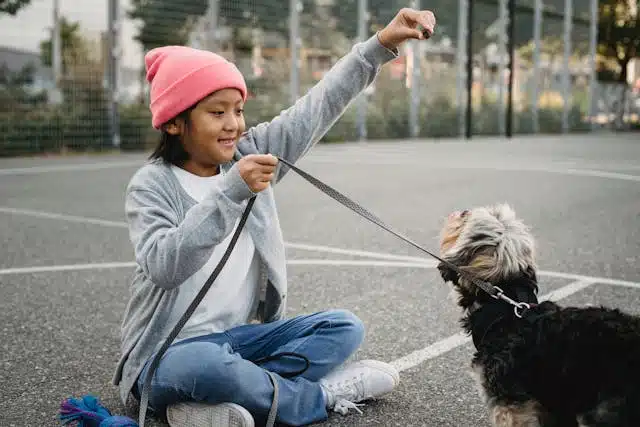Curious about how to teach dog to lie down with a hand signal? Don’t worry, I’ve got you covered. Today, I’m going to teach you how to train your dog to lie down using a hand signal. This is a staple trick and a good starting point for many more advanced tricks. Follow along as I guide you through five easy steps to master this essential command.
So, why do we even teach this with a hand signal? Well, dogs communicate through body language, so it takes them a lot longer to wrap their heads around spoken words. When we just say commands to them, it takes them a lot longer to learn. Whereas, if we use a hand signal, not only will they learn a lot faster, but they will also learn it more solidly in their body, so they will do it every time we ask.
Before diving in, make sure that you are stocked up on a lot of really tasty treats, something that your dog is going to want to work really hard for. Usually, the smellier the better for this, and I find soft, small treats are a lot easier for dogs to eat during training. So, make sure you stock up on a lot of those. If your dog doesn’t seem very enthusiastic about it, then maybe your treats just aren’t of a high enough value, and you need to get something that’s a little bit more appetizing to your dog.
Table of Contents
ToggleStep 1: Position the Treat
Place the treat in front of your dog’s nose, so that they know you have something good.
Step 2: Move the Treat Downward
Move your hand with the treat slowly toward the ground. Your dog’s nose should follow. What we want is for the body to follow as well. Don’t move too fast, or your dog will get confused. Do this many times so that your dog understands. If your dog’s butt isn’t touching the ground and they’re just kind of in a downward dog position, then try moving the treat closer to your dog’s chest.
You’ll notice that we aren’t actually using the word “down” yet. That’s because of what I mentioned before about dogs understanding body language quicker than spoken words. So, we’re going to save the word until the very end. First, we want them to understand what the hand signal means, and then we’ll throw the word onto it at the end.
Step 3: Practice Without the Treat
Do the same motion but without food in your luring hand. Your luring hand is the hand that has food in it, closest to their face. You’re still rewarding but do it at the end with the other hand. You may want to intermittently have food in your lure hand to keep your dog interested. Over time, you can decrease the amount of time the food is in your lure hand until you get to the point that you’re only ever rewarding with your other hand.
Step 4: Add the Verbal Command
When your dog begins to understand, you don’t need to bring your hand all the way down to the ground but start doing this signal, which is generally a flat hand with the palms down, but I tend to just point to the ground. In time, tune your hand up until you are standing upright.
It’s not until the very end that you start using the word “down.” Now your dog understands that this motion is associated with the hand signal, but what we want to do is associate it with the hand signal and the word. So how you do that is you say the word “down” and then do the hand signal. Very soon, your dog is going to understand that the word “down” and the hand signal mean the same thing.
Tips for Different Dogs
Some dogs, like French Bulldogs and other types of bulldogs, do have a harder time doing this down command, and that’s just because of the way their bodies are. It’s a little harder and more uncomfortable for them to lie down in this way. That being said, it is totally possible for them to do it; it may just take you a little bit longer. Also, be mindful of doing this trick with very old dogs or dogs who have any kind of hip problems, like hip dysplasia, because it can be really difficult on their bodies.
And that is how to train dog to lie down with a hand signal in five easy steps. Teaching your dog this skill isn’t just about commands—it’s about building a stronger connection and understanding between you and your loyal companion. With patience, consistency, and plenty of encouragement, you’ll see your furry friend grasp this essential skill. Keep the training sessions lively and enjoyable for both of you and celebrate each small victory along the way.



